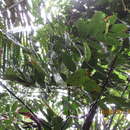en
names in breadcrumbs


Protium copal, commonly known as the copal tree, is a species of tree endemic to Mexico and Central America. It is found in wet tropical forests, preferring heavy shade.[1] It grows to 30 metres (98 ft) in height and has long leathery leaves.[1] The fruits are small (2–3 cm) and smooth, with a single pit.[1]
The dried sap of the tree is known as copal. It is commonly used as an incense, similar to frankincense.[1]
Protium copal, commonly known as the copal tree, is a species of tree endemic to Mexico and Central America. It is found in wet tropical forests, preferring heavy shade. It grows to 30 metres (98 ft) in height and has long leathery leaves. The fruits are small (2–3 cm) and smooth, with a single pit.
The dried sap of the tree is known as copal. It is commonly used as an incense, similar to frankincense.